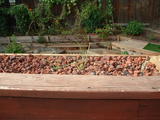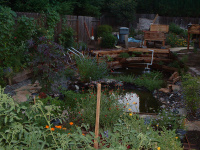This will give instructions for making a grow bed box out of wood. This does not include the mounting, underneath support, or the liner and drains. Each of these steps will have there own set of instructions. I feel this is a better way to go. A few small sets of instructions rather than one massive set of instructions is easier to follow IMO.
So here we go, the first of daily(or almost daily) instructions to cover everything this project entailed.
HOW TO MAKE A GROW BED
Materials needed:
15 - 2" x 4" x 8' fir or redwood studs
1 - 4' x 8' x 5/8" plywood
9 - 2" x 4" x 8' redwood studs(you can also use 1x4 redwood)
1lb - 1 5/8" wood screws
1lb - 2 1/2" or 3" wood screws
12 - 90degree angle brackets(any type, make sure they are strong)
4 - 24" strap ties(any type and you can get away with using only 2)
1lb - 1" nails or wood screws
Step 1
Take 2 of your studs and lay them on a flat surface. Spread them 4 feet apart and place the plywood on top of them. With the studs smaller sides contacting the floor and the plywood, line up the studs with the edges of the plywood. Secure them by screwing through the plywood into the studs every 6 inches with 1 5/8" screws.

Now measure the distance between the two mounted studs, it should be 45", but always measure for certainty. Cut 2 boards at that length using 1 of the studs. Now place the newly cut boards in between the mounted studs and secure with 1 5/8" screws by screwing through the plywood into the boards. Next, connect the mounted 2x4's at the corners with 3" screws. Image 1 below shows the details.
Now turn the plywood so it is face down with the mounted 2x4's on top. Take 8 of the angle brackets and mount them as shown in image #1 below.
Step 2
Now you are going to build the side walls up using 2x4's. You will want to take the studs and build 4 boxes. You will do as you did when mounting them to the plywood, but this time you will be adding the studs in between to form the box first. Using the exact same measurement(45") cut 8 lengths of board using 4 studs. Line up 2 of the newly cut boards between the ends of two studs and screw them together using 3" screws as in image 2A below. It is important that all these boxes are the exact same size, 4' x 8'. Don't worry if the corner angles are not exactly perfect at this point.
Once the boxes are complete take one and place it on top of the box mounted to the plywood. Take a 3" screw and, going in at an angle, mount it to the box below it. Repeat this with each box until you have an almost complete grow bed. Image 2B below shows the details.
Now take a strap tie and secure each board to the one below it on the inside of each wall using 1" screws or nails. Repeat for each side.
Step 3
Now we will make it look better and at the same time make it stronger. Take 1 of the redwood studs. Find the center of it and draw cut lines at 45 degree angles as shown in figure 3A below.
Now take 2 redwood studs and cut the ends at 45 degree angles to match up with the smaller boards, forming a rectangle. Screw them together with 3" screws as shown in image 3B below. You will first have to drill guide holes to prevent the wood from splitting. A 1/8" or a 5/32" drill bit will work. Once you have it complete, set it on top of the grow bed and secure with 3" screws as shown in image 3B below.
Now using the remainder of the redwood cut and secure trim as shown in image 3c below. You don't have to use the exact patterns I did, but make sure you have at least one center board that connects all of the wall studs. This will prevent the walls from bowing out when filled and only needs to be done on the two long walls.

In the picture above I used a different, and stronger pattern. I was running out of wood and money at this point, so the trim is not all redwood.
That is it. Next I will show you how to make the mounting supports for the bottom of the bed once it is mounted.


































































